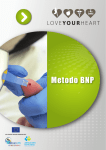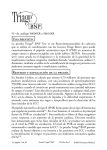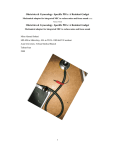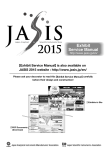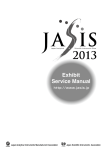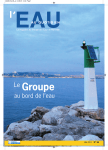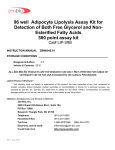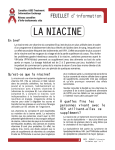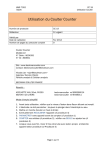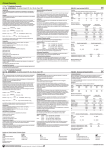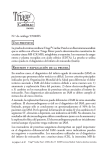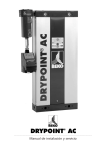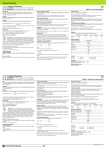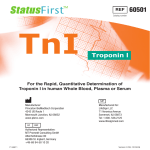Download Triage® BNP Test Product Insert - Drug testing supplies from CLIA
Transcript
Triage BNP Test Product Insert ® Rapid Quantitative Test for B-type Natriuretic Peptide Triage BNP Test ® Product Insert Product Insert Catalog # 98000XR Intended Use The Alere Triage® BNP Test is a rapid, point of care fluorescence immunoassay to be used with the Alere Triage® Meters for the quantitative measurement of B-type natriuretic peptide (BNP) in EDTA anticoagulated whole blood or plasma specimens. The test is intended to be used as an aid in the diagnosis and assessment of severity of congestive heart failure (also referred to as heart failure). The test also is used for the risk stratification of patients with acute coronary syndromes and for the risk stratification of patients with heart failure. Summary and Explanation of the Test It is estimated that 5.8 million people in the United States have heart failure with approximately 670,000 new cases occurring each year.1 Congestive heart failure (CHF) occurs when the heart cannot deliver a sufficient amount of blood to the body.2 This condition can occur at any age but is most prevalent in an aged population. Symptoms of CHF include shortness of breath, fluid retention and respiratory distress. These symptoms are often vague and nonspecific for detecting early stages of CHF.2 B-type natriuretic peptide (BNP) is a member of a class of hormones that regulate blood pressure.3,4 The heart is the main source of circulating BNP in humans.5,6 The molecule is released into the blood in response to increased heart pressure. Various studies have demonstrated that increased levels of circulating BNP are found in early stages of CHF. The level of BNP in the blood continues to increase as the CHF disease advances.7 The Alere Triage® BNP Test offers an objective, noninvasive measurement for assessing patients for CHF and risk stratification in patients with acute coronary syndromes (ACS).7,8 Principles of the Procedure The Alere Triage® BNP Test is a single use fluorescence immunoassay device designed to determine the concentration of BNP in EDTA anticoagulated whole blood or plasma specimens. The test procedure involves the addition of several drops of an EDTA anticoagulated whole blood or plasma specimen to the sample port on the Test Device. After addition of the specimen, the whole blood cells are separated from the plasma using a filter contained in the Test Device. The specimen reacts with fluorescent antibody conjugates and flows through the Test Device by capillary action. Complexes of each fluorescent antibody conjugate are captured on discrete zones specific to the analyte. The Test Device is inserted into the Alere Triage® Meter (hereafter referred to as Meter). The Meter is programmed to perform the BNP analysis after the specimen has reacted with the reagents within the Test Device. The concentration of BNP in the specimen is directly proportional to the fluorescence detected. The results are displayed on the Meter screen in approximately 15 minutes from the addition of specimen. The analysis is based on the © 2011 Alere. All rights reserved. 1 amount of fluorescence the Meter detects within a measurement zone on the Test Device. A greater amount of fluorescence detected by the Meter indicates a higher BNP concentration in the specimen. All results are stored in the Meter memory to display or print when needed. If connected, the Meter can transmit results to the lab or hospital information system. Reagents and Materials Provided The Alere Triage® BNP Test contains all reagents necessary for the quantification of BNP in EDTA anticoagulated whole blood or plasma specimens. The Test Device contains: • Murine monoclonal antibodies and polyclonal antibodies against BNP. • Fluorescent dye. • Stabilizers. Alere Triage® BNP Test Catalog # 98000XR Kit contains: 25 Test Devices 25 Transfer Pipettes 1 Reagent CODE CHIP™ Module 1 Printer Paper Roll Materials Required but Not Provided Alere Triage® MeterPro Catalog # 55070 or 55071 Triage® MeterPlus Catalog # 55040 or 55041 Alere Triage® BNP Control 1 Alere Triage® BNP Control 2 OR Catalog # 98013XR Catalog # 98014XR Alere Triage® Total 5 Control 1 Alere Triage® Total 5 Control 2 Catalog # 88753 Catalog # 88754 Warnings and Precautions • For In Vitro Diagnostic Use. • For use by healthcare professionals. • Do not use the kit beyond the expiration date printed on the outside of the box. • Carefully follow the instructions and procedures described in this insert and the quick 2 © 2011 Alere. All rights reserved. reference instruction. • Optimal results will be achieved by performing testing at temperatures between 20-24ºC (68-75ºF). • If results from multiple specimens from the same patient will be compared, it is recommended to maintain a consistent sample type (whole blood or plasma). • Sample dilution is not recommended. • The use of non-Alere Controls and Calibration Verification materials is not recommended. • Keep the Test Device in the sealed pouch until ready for immediate use. Discard after single use. • The transfer pipette should be used for one patient specimen only. Discard after single use. • Patient specimens, used Test Devices and used transfer pipettes may be potentially infectious. Proper handling and disposal methods should be established by the laboratory in accordance with local, state and federal regulations. • The Alere Triage® BNP Test should not be used as absolute evidence for CHF. The results should be interpreted along with clinical findings and other laboratory test results. • Blood concentrations of BNP may be elevated in patients who are experiencing a heart attack, patients that are candidates for renal dialysis, and patients that have had renal dialysis. Storage and Handling Requirements • Store the Test Devices in a refrigerator at 2-8°C (35-46°F). • Once removed from refrigeration, the pouched Test Device is stable for up to 14 days at room temperature, but not beyond the expiration date printed on the pouch. With a soft, felt tip marker, gently write the date and time of removal from the refrigerator on the pouch and cross out the manufacturer expiration date printed on the pouch. Care must be taken to document the time the product is at room temperature. Once equilibrated to room temperature, do not return the Test Device to refrigeration. • Before using refrigerated Test Devices, allow individual foil pouches to reach operating temperature (20-24°C or 68-75°F). This will take a minimum of 15 minutes. If a kit containing multiple Test Devices is removed from refrigeration, allow the kit to reach room temperature before use. This will take a minimum of 60 minutes. • Do not remove the Test Device from the pouch until prepared for immediate use. © 2011 Alere. All rights reserved. 3 Specimen Collection and Preparation • A venous whole blood or plasma specimen using EDTA as the anticoagulant is required for testing with this product. Other blood specimen types have not been evaluated. Use of plastic blood draw tubes containing K2 EDTA as an anticoagulant for sample collection permits an accurate measurement of plasma BNP concentrations (Davidson et al., Circulation 91: 1276, 1995). • For sample collection, follow the sample tube manufacturer’s recommended procedure. • Blood and plasma specimens may be stored at room temperature (or chilled) for testing within 7 hours of collection. Plasma specimens may be stored chilled for testing within 24 hours of collection. Transport specimens at room temperature or chilled and avoid extreme temperatures. • If testing cannot be completed within 24 hours, the plasma should be separated and stored at -20 °C until it can be tested. • Avoid using severely hemolyzed specimens whenever possible. If a specimen appears to be severely hemolyzed, another specimen should be obtained and tested. Test Procedure Lot Calibration Using the Reagent CODE CHIP™ Module When a new lot of Test Devices is opened, the calibration and expiration data for that lot of Test Devices must be transferred to the Meter before patient testing. Use the Reagent CODE CHIP™ module supplied with the new lot of Test Devices to transfer the data to the Meter. Reagent CODE CHIP™ Module Perform one time for each new lot of Test Devices 1. From the main screen, select Install New Code Chip. Press Enter. 2. Place the Reagent CODE CHIP™ module into the lower left front corner of the Meter and follow the prompts on the screen. 3. Remove the Reagent CODE CHIP™ module from the Meter when data transfer is complete. 4. 4 Place the Reagent CODE CHIP™ module back into its original container for storage. © 2011 Alere. All rights reserved. Testing Patient Specimens Procedural Notes • For each day of patient testing, perform QC Device testing. Refer to the Quality Control Considerations section. • Frozen plasma and refrigerated whole blood or plasma specimens must be allowed to reach room temperature and be mixed thoroughly before testing. • Mix whole blood specimens by gently inverting the tube several times. • Mix plasma specimens by vortexing or inverting the tube several times. STEP 1- Add Patient Specimen 1. Open the pouch and label the Test Device with the patient identification number. 2. Place the Test Device on a level, horizontal surface. 3. Using the transfer pipette, squeeze the larger (top) bulb completely and insert the tip into the specimen. 4. Release the bulb slowly. The transfer pipette barrel should fill completely with some fluid flowing into the smaller (lower) bulb. 5. Place the tip of the transfer pipette into the sample port of the Test Device and squeeze the larger bulb completely. The entire volume of fluid in the transfer pipette barrel must flow into the sample port. The specimen in the smaller (lower) bulb will not be expelled. 6. Remove the transfer pipette tip from the sample port and then release the larger (top) bulb. 7. Discard the transfer pipette. 8. Allow specimen to absorb completely before moving the Test Device. STEP 2- Run Test 1. From the main screen, select Run Test and press Enter. 2. Select Patient Sample and press Enter. 3. Enter the patient identification number and press Enter. 4. Confirm that the number was entered correctly by selecting Confirm Patient ID and pressing Enter. If the number was not entered correctly, select Correct Patient ID, press Enter and repeat the previous step. 5. Holding the Test Device by the edges, insert the Test Device into the Meter and press Enter. The result will be displayed when the analysis is complete. Note: The Test Device must be inserted into the Meter within 30 minutes from the time the patient specimen was added. A delay longer than 30 minutes may cause the results to be invalid and blocked out on the printout. STEP 3- Read the Results 1. Results may be printed by pressing the Print button. 2. Discard the Test Device after release from the Meter. 3. A blocked out result indicates the result was invalid and the test should be repeated. © 2011 Alere. All rights reserved. 5 Results The Meter measures the target analyte automatically. The result is displayed on the screen. The operator has the option to print the results. A number in pg/mL represents the amount of BNP present in the sample. For additional information, refer to the Alere Triage® Meter User Manual. • The BNP range reported by the test system is 5 pg/mL to 5000 pg/mL. Standardization The Alere Triage® BNP Test has been standardized using a purified protein preparation of BNP based on the mass (concentration) of the analyte present in EDTA anticoagulated plasma. Quality Control Considerations Every Alere Triage® BNP Test is a quantitative test that includes two internal control materials of different concentrations that are run automatically with every patient specimen, external liquid control solution, or proficiency testing sample. If the automatic check of these built-in controls shows that the control value results are within the limits set during manufacturing, the Meter will report a result for the specimen being tested. If the automatic check of these built-in controls shows that the control value results are not within the limits set during manufacturing, a test result will not be reported. Instead, the Meter will display a warning or error message that is described in the Alere Triage® Meter User Manual. Good Laboratory Practice suggests that external controls should be tested with each new lot or shipment of test materials, or every 30 days, and as otherwise required by your laboratory’s standard quality control procedures. Controls should be tested in the same manner as if testing patient specimens. When running patient specimens or external controls, if an analyte fails for any reason (built-in control failure or an external control out of range) no patient results will be reported. Users should follow government guidelines (for example, federal, state or local) and/or accreditation requirements for quality control. Performing Alere Triage® System Quality Control – QC Device Use the QC Device to ensure proper function of the Meter. Perform QC Device testing for the following conditions: • • • • • Upon initial setup of the Meter. Each day of patient testing. When the Meter has been transported or moved. Whenever there is uncertainty about the performance of the Meter. Whenever required by your laboratory’s quality control requirements. Do not discard the Alere Triage® QC Device and associated CODE CHIP™ module. Store them in the QC Device Box. Refer to the Alere Triage® User Manual for complete instructions on use of the QC Device. 1. 6 The first time a new QC Device is run in the Meter, install the QC Device CODE CHIP™ module. The QC Device CODE CHIP™ module data is stored in the Meter memory. The QC Device CODE CHIP™ module does not need to be reinstalled after the first time. © 2011 Alere. All rights reserved. QC Device CODE CHIP™ Module a. From the main screen, select Install New Code Chip and press Enter. b. Place the QC Device CODE CHIP™ module into the lower left front corner of the Meter. Follow the prompts on the screen. c. Remove the QC Device CODE CHIP™ module from the Meter when data transfer is complete. d. Place the QC Device CODE CHIP™ module back into the QC Device Box for storage. 2. From the main screen, select Run Test and press Enter. 3. If User ID is enabled enter your User ID number and press Enter. 4. Select QC Device and press Enter. 5. Insert QC Device into the Meter and press Enter. 6. A Pass or Fail result will be displayed/printed when complete. Each parameter should pass before patient testing is performed. 7. Remove the QC Device from the Meter and place in the QC Device Box. DO NOT DISCARD THE QC DEVICE. Note: If the QC Device or external controls do not perform as expected, review the above instructions to see if the test was performed correctly, repeat the test, or contact Alere or your local Alere representative (refer to Contact Alere section). Refer to the Alere Triage® Meter User Manual for a complete description of the quality control system. CLIA Considerations The Alere Triage® BNP Test is a CLIA-waived test system for whole blood only. Each laboratory or testing site using the Alere Triage® BNP Test must have a CLIA Certificate of Waiver before starting testing. To obtain a Certificate of Waiver, call your state department of health or contact Alere for an application (Form CMS-116). Alere San Diego, Inc. can provide the phone number of your state department of health and assist you in filling out the application. © 2011 Alere. All rights reserved. 7 The Alere Triage® BNP Test is a waived test so long as it is used according to the instructions set in the Package Insert. Any modification by the laboratory to the test system or the test system instructions will result in this test no longer meeting the requirements for waived categorization. A modified test is considered to be high complexity and is subject to all applicable CLIA requirements. Results of Untrained User Study An “untrained user” study was conducted in which participants were given only the test instructions and asked to perform testing of three (3) prepared samples at three different BNP levels (low, medium, and high) in random order. The participants were not given any training on the use of the test. A total of 65 participants were enrolled from 3 sites, representing a diverse demographic (educational, age, gender) population. The table below presents the summary of the performance by the untrained users: Level 1 Low Level 2 Medium Level 3 High Concentration* 45.6 227 2244 Number of Measurements 65 65 65 44.8 (43.7; 45.8) 218 (213; 223) 2166 (2105; 2227) Average 95% Confidence Interval Standard Deviation %CV Observed Range 4.1 21.7 247 9.2% 10.0% 11.4% 37.2 – 64.1 166 – 273 1570 – 2730 *Concentration of BNP in a sample was an average of total number of 20 measurements by a trained laboratory professional using the Triage BNP Test. A physician office laboratory (POL) study was conducted at four physician offices using 60 EDTA-anticoagulated whole blood samples from apparently healthy volunteers. Each sample was tested by two physician office employees and by a trained laboratory professional. Results from the POL employees were compared to the trained laboratory professional’s results using a Deming regression. The results of the regression analysis were the following: slope=1.01 with 95% Confidence Interval: 0.97 to 1.04; intercept=0.4 with 95% Confidence Interval: -0.4 to 1.1. The average coefficient of variation for the two measurements on each sample by the POL employees for the BNP range of 5 pg/mL to 78 pg/mL was 13.5%. Limitations of the Procedure • Test results should be evaluated in the context of all the clinical and laboratory data available. In those instances where test results do not agree with the clinical evaluation, additional tests should be performed accordingly. • Severely hemolyzed specimens should be avoided. When a sample appears to be severely hemolyzed, another specimen should be obtained and tested. 8 © 2011 Alere. All rights reserved. • This test has been evaluated with venous whole blood and plasma using EDTA as the anticoagulant. Other specimen types, draw methods, or anticoagulants have not been evaluated. Use standard venipuncture techniques. Follow the sample collection recommendations of the sample tube manufacturer. • There is the possibility that factors such as technical or procedural errors, as well as interfering or cross-reacting substances in patient specimens, may impact the test and cause erroneous results. • These assays are fluorescence immunoassays and may be affected by environmental conditions. Therefore, it is important for each laboratory to establish its own reference range based on the laboratory conditions and procedures. Expected Values • BNP results less than or equal to 100 pg/mL are representative of normal values in patients without CHF. • BNP results greater than 100 pg/mL are considered abnormal and suggestive of patients with CHF. • BNP results of >5000 pg/mL are considered very high values for BNP and exceed the upper limits of the BNP test. • Higher BNP concentrations measured in the first 72 hours after an acute coronary syndrome are associated with an increased risk of death, myocardial infarction, and CHF. • Higher BNP concentrations or the lack of a decrease in the BNP concentration from hospital admission to discharge indicate an increased risk of hospitalization or death in patients with heart failure. Each laboratory should establish a reference range that is representative of the patient population to be evaluated. Additionally, each laboratory should consider the current practice in the evaluation of patients experiencing symptoms at each institution. Performance Characteristics Linearity Plasma specimens anticoagulated with EDTA from four apparently healthy individuals were spiked with purified BNP to final concentrations of 5000 pg/mL. Each spiked plasma specimen was diluted gravimetrically with unspiked plasma to obtain BNP values throughout the range of the Alere Triage® BNP Test. Linear regression analysis of the data indicates that the assay is linear throughout the measurable range of the test. Recovery data representing results from nine measurements are shown below. Percent Recovery Donor 1 Donor 2 Donor 3 Donor 4 Level 1 94.1% 95.9% 91.8% 100.4% Level 2 85.6% 97.0% 90.1% 94.2% Level 3 104.7% 101.7% 97.8% 105.0% Level 4 102.8% 93.8% 98.9% 105.8% © 2011 Alere. All rights reserved. 9 Percent Recovery Donor 1 Donor 2 Donor 3 Donor 4 Level 5 92.0% 86.4% 94.3% 99.0% Level 6 102.7% 108.3% 100.1% 93.7% Level 7 110.7% 106.5% 110.3% 104.6% Level 8 101.2% 111.8% 123.4% 105.0% Level 9 106.3% 98.6% 93.1% 92.3% Analytical Sensitivity The analytical sensitivity or lowest detectable concentration that is distinguishable from zero for the Alere Triage® BNP Test was determined by testing a zero calibrator 20 times each using 3 lots of reagents and 5 Meters on 5 days. The average 95% confidence limit of the analytical sensitivity of the Alere Triage® BNP Test was less than 5 pg/mL. Interfering Substances Hemoglobin (up to 1,000 mg/dL), lipids (cholesterol up to 1,000 mg/dL and triglycerides up to 1,000 mg/dL) or bilirubin (up to 20 mg/dL) added to plasma specimens containing BNP did not interfere with the recovery of BNP. The hematocrit was varied between 27% and 51% with no significant effect on the recovery of BNP. Analytical Specificity Pharmaceuticals The following drugs were evaluated for potential cross-reactivity and interference in the Alere Triage® BNP Test. All drugs were tested at concentrations representing the blood concentrations that would result from a maximal therapeutic dose and at least twice the maximal therapeutic dose. There was no significant interference with the BNP measurement, nor was there any assay cross-reactivity. Abciximax Dopamine Nitroglycerin Acetaminophen Enalapril Maleate Noraminopyrine Acetylsalicylic acid Dipyridamole Oxazepam Activase Erythromycin Oxytetracycline Allopurinol Furosemide Phenobarbital Amiodarone Eptifibatide Phenytoin Ampicillin Hydralazine Probenecid Ascorbic Acid Hydrochlorothiazide Procainamide Amlodipine Besylate Heparin Propanolol Atenolol Isosorbide dinitrate Quinidine 10 © 2011 Alere. All rights reserved. Caffeine Indomethacin Simvastin Captopril Lisinopryl Sulfamethoxazole Cyclosporine Lovastatin Theophylline Chloramphenicol Methyldopa L-thyroxine Clopidogrel Bisulfate Mirinone lactate Trimethoprim Diclofenac Nicotine Verapamil Digoxin Nicotinic Acid Warfarin Diltiazem Niphedipine Digitoxin Nitrofurantoin Proteins and Peptides The following proteins and peptides were evaluated for potential cross-reactivity and interference with the Alere Triage® BNP Test at the concentrations indicated below. There was no significant interference with the BNP measurement, nor was there any significant assay cross-reactivity. Reactivity with Related Proteins and Peptides Concentration of Substance % Recovery Renin Substance 50 ng/mL 104% Aldosterone 1 µg/mL 104% Angiotensin I 600 pg/mL 108% Angiotensin II 600 pg/mL 108% Endothelin I 20 pg/mL 101% Adrenomedullin (ADM) 1000 pg/mL 97% Alpha-Atrial Natriuretic polypeptide 1-28 1000 pg/mL 104% Prepro BNP 22-46 1000 pg/mL 104% Prepro BNP 1-21 1000 pg/mL 106% Arg Vasopressin 1000 pg/mL 96% C-type Natriuretic Peptide 53 1000 pg/mL 106% Prepro-ANF 56-92 1000 pg/mL 104% Prepro-ANF 104-123 1000 pg/mL 97% Urodilatin (CCD/ANP) 95-126 1000 pg/mL 100% Angiotensin III 1000 pg/mL 108% Prepro-ANF 26-55 1000 pg/mL 107% © 2011 Alere. All rights reserved. 11 Precision The average within-day and total precision were determined using the ANOVA model by testing control materials that had BNP added at concentrations near the decision points of the assay and throughout the range of the standard curve. The study was conducted over 12 days, testing each control 10 times per day. Each Test Device was read on five Triage® Meters. Of particular note, the use of different Meters does not significantly affect the test precision. Average Within Day Imprecision Mean (pg/mL) Standard Deviation (pg/mL) CV 71.3 6.3 8.8% 629.9 69.1 11.0% 4087.9 475.5 11.6% Standard Deviation (pg/mL) CV Average Total Imprecision Mean (pg/mL) 71.3 7.0 9.9% 629.9 75.5 12.0% 4087.9 500.1 12.2% Whole Blood vs. Plasma Correlation A comparison study was performed on EDTA whole blood vs. plasma. The correlation data shows r2=0.9878, y= 0.925x + 13.439. Data from Clinical Studies Individuals Without CHF The circulating BNP concentration was determined from 1286 individuals without CHF (676 women and 610 men) using the Alere Triage® BNP Test. This population included individuals with hypertension, diabetes, renal insufficiency, and chronic obstructive pulmonary disease. There are no statistically significant changes in BNP concentration associated with hypertension, diabetes, renal insufficiency, and chronic obstructive pulmonary disease. The descriptive statistics for BNP concentrations in individuals without CHF are shown in the table below. The values are representative of the values obtained from clinical studies. The decision threshold was determined by the 95% confidence limit of BNP concentration in the non-CHF population age 55 and older. The most appropriate decision threshold apparent from these distributions is 100 pg/mL. This value translates into a general specificity of the test of 98%, i.e. less than 2% expected false positives in individuals without CHF. Each laboratory should establish a reference range that represents the patient population that is to be evaluated. 12 © 2011 Alere. All rights reserved. Descriptive Statistics – BNP Concentration (pg/mL) Non-CHF Population All All Age < 45 Age 45-54 Age 55-64 Age 65-74 Age 75+ Median 12.3 7.7 11.1 17.9 19.8 53.9 95th Percentile 73.5 39.6 64.5 76.1 84.7 179.4 Percent < 100 pg/mL 98.0% 99.5% 99.2% 97.4% 96.9% 84.2% Minimum 5.0 5.0 5.0 5.0 5.0 5.0 Maximum 252.0 251.3 252.0 207.7 197.9 218.5 N 1286 423 385 229 192 57 Males All Age < 45 Age 45-54 Age 55-64 Age 65-74 Age 75+ Median 7.1 5.0 7.2 9.0 15.7 39.0 95th Percentile 56.9 23.8 39.0 72.4 62.7 77.9 Percent < 100 pg/mL 98.9% 98.9% 99.5% 98.3% 98.9% 95.8% Minimum 5.0 5.0 5.0 5.0 5.0 5.0 Maximum 252.0 251.3 252.0 207.7 127.3 218.5 610 183 196 118 89 24 N Females All Age < 45 Age 45-54 Age 55-64 Age 65-74 Age 75+ Median 18.5 11.6 17.7 28.2 27.6 67.1 95th Percentile 84.2 47.4 71.7 80.5 95.4 179.5 Percent < 100 pg/mL 97.2% 100.0% 98.9% 96.4% 95.1% 75.8% Minimum 5.0 5.0 5.0 5.0 5.0 5.0 Maximum 197.9 92.6 142.8 143.2 197.9 194.1 676 240 189 111 103 33 N © 2011 Alere. All rights reserved. 13 Individuals with CHF Blood samples were obtained from 804 patients diagnosed with CHF (246 women and 558 men). The descriptive statistics for BNP concentrations in patients with CHF are presented in the table below. These values are representative of the values obtained from clinical studies. Each laboratory should establish a reference range that represents the patient population that is to be evaluated. In addition, laboratories should be aware of their respective institutions’ current practice for the evaluation of patients with CHF. CHF Population – All All CHF* NYHA Functional Class I II III IV Median 359.5 95.4 221.5 459.1 1006.3 5th Percentile 22.3 14.8 9.9 37.6 147.2 Percent > 100 pg/mL 80.6% 48.3% 76.6% 86.0% 96.3% Minimum 5.0 5.0 5.0 5.2 5.0 Maximum >5000 904.6 4435.8 >5000 >5000 804 118 197 300 187 N CHF Population – Males All CHF* NYHA Functional Class I II III IV Median 317.8 87.8 232.6 458.9 1060.3 5th Percentile 21.9 16.8 10.7 25.0 196.5 Percent > 100 pg/mL 78.9% 46.5% 78.8% 85.2% 97.2% Minimum 5.0 5.0 5.0 5.2 5.0 Maximum >5000 904.6 2710.6 >5000 >5000 558 101 146 203 106 N 14 © 2011 Alere. All rights reserved. CHF Population – Females All CHF* NYHA Functional Class I II III IV Median 499.7 114.7 191.2 469.2 996.5 5th Percentile 30.7 6.8 9.7 45.6 121.0 Percent > 100 pg/mL 84.6% 58.8% 70.6% 87.6% 95.1% Minimum 5.0 5.0 5.0 11.7 15.5 Maximum >5000 519.6 4435.8 4582.0 4706.5 246 17 51 97 81 N *2 CHF with unknown NYHA Functional Class (male) The New York Heart Association (NYHA) developed a four-stage functional classification system for CHF that is based on a subjective interpretation of the severity of a patient’s clinical signs and symptoms. Class I patients have no limitations of physical activity and have no symptoms with ordinary physical activity. Class II patients have a slight limitation of physical activity and have symptoms with ordinary physical activity. Class III patients have a marked limitation of physical activity and have symptoms with less than ordinary physical activity, but not at rest. Class IV patients are unable to perform any physical activity without discomfort. Reports in the scientific literature have indicated that there is a relationship between BNP and the severity of CHF.2,7,9-11 An analysis of NYHA classification and BNP concentrations from the clinical study data indicate that there is a relationship between the severity of the clinical signs and symptoms of CHF and BNP concentration. These data are consistent with the previous reports in the literature, and further demonstrate that BNP measurements, along with NYHA classification, can provide additional objective information to the physician about the patient’s CHF severity. Median BNP Concentration (pg/mL) BNP vs. NYHA Classification 1200 1000 800 600 400 200 0 NonCHF NYHA Class I NYHA Class II NYHA Class III NYHA Class IV © 2011 Alere. All rights reserved. 15 Diagnostic Utility Various studies have demonstrated that circulating BNP concentrations increase with the severity of CHF based on the NYHA classification. BNP concentrations are much lower than ANP concentrations normally, but as the severity of CHF advances according to the NYHA classification, plasma BNP increases progressively more than respective ANP values.6 Therefore, BNP is a more useful marker than ANP to distinguish between normal subjects and patients in the earlier stages of CHF. BNP is more sensitive and specific than ANP for detecting decreases in LVEF.7,9 Additionally, there is a positive correlation between blood BNP concentrations and left ventricular end diastolic pressure and inverse correlation to left ventricular function following acute myocardial infarction.9 Blood BNP concentrations represent an independent assessment of ventricular function without the use of other invasive or expensive diagnostic tests.9 There is an association with elevated BNP concentrations and alterations in hemodynamic parameters including raised atrial and pulmonary wedge pressures, reduced ventricular systolic and diastolic function, left ventricular hypertrophy, and myocardial infarction.12 Numerous reports in the scientific literature have described the utility of BNP as a diagnostic marker for CHF and left ventricular dysfunction.1,2,7,9-16 These observations are supported by an analysis of the clinical study data. The Receiver Operating Characteristic (ROC) Curve of BNP cut-offs versus clinical sensitivity and specificity from the clinical study data is provided below. The area under the curve is 0.955 ± 0.005. The clinical utility of the Alere Triage® BNP Test also has been confirmed and described in detail in the scientific literature.17,18 ROC Curve 100.0% 90.0% 80.0% 70.0% Sensitivity 60.0% 80 60 100 125 150 180 200 40 5 20 50.0% 40.0% 500 30.0% 20.0% 1000 10.0% 0.0% 0.0% 20.0% 40.0% 60.0% 1-Specificity 16 © 2011 Alere. All rights reserved. 80.0% 100.0% A box and whiskers plot for the clinical study population is provided below, with a horizontal dashed line representing the suggested cutoff of 100 pg/mL. 1.400 1.300 1.200 1.100 1.000 BNP (pg/mL) 900 800 700 600 500 400 300 200 100 0 N= 1.286 804 Non-CHF CHF The clinical sensitivity and specificity of the Alere Triage® BNP Test using a cutoff of 100 pg/ mL for various age groups within each gender is described in the table below. Males Sensitivity 95% Confidence Interval Specificity 95% Confidence Interval Age < 45 Age 45-54 Age 55-64 Age 65-74 Age 75+ 81.6% 76.0% 75.6% 79.3% 82.4% 70.8-92.5% 67.5-84.6% 68.2-82.9% 72.6-86% 76.1-88.7% 98.9% 99.5% 98.3% 98.9% 95.8% 97.4-100.0% 98.5-100.0% 97.7-98.9% 98.4-99.4% 94.7-96.9% © 2011 Alere. All rights reserved. 17 Females Sensitivity 95% Confidence Interval Specificity 95% Confidence Interval Age < 45 Age 45-54 Age 55-64 Age 65-74 Age 75+ 82.1% 69.0% 82.4% 97.9% 91.9% 68.0-96.3% 57.1-80.9% 71.9-92.8% 93.7-100.0% 85.2-98.7% 100.0% 98.9% 96.4% 95.0% 75.7% 100.0-100.0% 97.5-100.0% 95.5-97.4% 93.4-96.7% 72.2-79.2% It has been reported that BNP has excellent utility as an aid in the diagnosis of patients with CHF and preserved systolic function (CHF-PSF), generally referred to as diastolic dysfunction.12,19-21 The diagnostic utility of BNP in CHF-PSF patients was determined from the clinical study data by determining the area under the ROC curve for individuals without CHF versus 155 individuals with CHF that had ejection fractions ≥50%. The area under the curve is 0.934 ± 0.012, which indicates that the test is effective as an aid in the diagnosis of CHF in patients with preserved systolic function. An age-matched analysis of the clinical data was performed with the following common age distribution in the groups of individuals with and without CHF: individuals less than 35 years old comprise 3% of the total number of observations, individuals age 35 to 44 comprise 6% of the total, individuals age 45 to 54 comprise 11% of the total, individuals 55 to 64 years old comprise 22% of the total, individuals 65 to 74 years old comprise 26% of the total, and individuals 75 years and older comprise 32% of the total. This age distribution reflects the prevalence of CHF within the age groups and genders, according to data published by the American Heart Association in the 2000 Heart and Stroke Statistical Update, and also reflects the age structure of the United States population, according to data published by the National Center for Health Statistics in Health, United States, 2000. The resulting area under the ROC curve is 0.930 with a 95% confidence interval of 0.902-0.958. Prognostic Utility in Patients with Acute Coronary Syndromes BNP concentrations measured in patients with acute coronary syndromes (ACS) or cardiovascular disease provide prognostic information about the patient’s risk for death and the development of CHF.12,22-26 Statistically significant increases in death, future myocardial infarction, and CHF have been associated with higher BNP concentrations measured within the first 72 hours after the onset of ACS symptoms. In a recent clinical study, BNP concentrations were evaluated in an observational, retrospective manner in patients with ACS (consisting of unstable angina, myocardial infarction with ST-segment elevation, or myocardial infarction without ST-segment elevation). BNP measurements were performed on specimens obtained within 72 hours after the onset of ischemic discomfort from a population of 2525 high-risk ACS patients that met standard diagnostic criteria for ACS. Patients whose BNP concentration was at least 80 pg/mL had higher rates of death, myocardial infarction, and CHF both at 30 days and at 10 months after presentation than 18 © 2011 Alere. All rights reserved. patients whose BNP concentration was below 80 pg/mL.8 In this population of patients with ACS, BNP measurements within the first 72 hours after the onset of symptoms provide useful predictive information to aid in the risk stratification of patients with ACS. Prognostic Utility in Patients with Heart Failure BNP concentrations measured at admission and/or discharge in patients with heart failure provide prognostic information about the patient’s risk for death or rehospitalization. A systematic review of studies investigating BNP for prognostic utility in patients with heart failure concluded that every 100 pg/mL increase in BNP concentration was associated with a 35% increase in the relative risk of death, and that admitted heart failure patients whose BNP values did not decrease over the course of their treatment are at a particularly high risk of death or a cardiovascular event.27 The authors also found that higher BNP concentrations in asymptomatic patients were prognostic for future death or cardiovascular events. Vrtovec et al and Harrison et al studied heart failure patients at the time of presentation and found that patients with higher BNP concentrations (> 1,000 pg/ mL and > 480 pg/mL, respectively) had a significantly higher risk of all-cause, cardiac, and pump-failure death and cardiac-related readmissions.28,29 Cheng et al and Bettencourt et al studied admitted heart failure patients receiving treatment and found that patients who did not experience death or readmission within 30 days or 6 months exhibited a decrease in BNP concentrations from admission to discharge, while patients whose BNP concentration did not decrease from admission to discharge were at significantly higher risk for adverse events.30,31 Logeart et al found that admitted heart failure patients with pre-discharge BNP concentrations of 350-700 pg/mL had a hazard ratio of 5.1 for death or readmission for heart failure within 6 months and patients with a pre-discharge BNP concentration greater than 700 pg/mL had a hazard ratio of 15.2 for the same endpoint compared to patients with a pre-discharge BNP concentration less than 350 pg/mL.32 Taken together, these studies indicate that higher BNP concentrations or the lack of a decrease in the BNP concentration from hospital admission to discharge indicate an increased risk of hospitalization or death in patients with heart failure. © 2011 Alere. All rights reserved. 19 Bibliography of Suggested Reading 1. http://www.cdc.gov/dhdsp/data_statistics/fact_sheets/fs_heart_failure.htm 2. Wu, A., B-Type natriuretic peptide and its clinical utility in patients with heart failure. Medical Laboratory Observer 10:10-14, 2001 3. Bonow, R. O., New insights into the cardiac natriuretic peptides. Circulation 93:19461950, 1996. 4. McDowell, G., Shaw, C., Buchanan, K., and Nicholls, D., The natriuretic peptide family. Eur. J. Clin. Invest. 25:291-298, 1995. 5. Yandle, T., Biochemistry of natriuretic peptides. J. Internal Med. 235:561-576, 1994. 6. Mukoyama, M., Nakao, K., Hosoda, K., Suga, S., Saito, Y., Ogawa, Y., Shirakami, G., Jougaski, M., Obata, K., Yasue, H., Kambayashi, Y., Inouye, K., and Imura, H., Brain natriuretic peptide as a novel cardiac hormone in humans: Evidence for an exquisite dual natriuretic peptide system, atrial natriuretic peptide and brain natriuretic peptide. J. Clin Invest. 87:1402-1412, 1991. 7. Clerico, A., Iervasi, G., Del Chicca, M.G., Emdin, M., Maffei, S., Nannipieri, M., Sabatino, L.,Forini, F., Manfredi, C., and Donato, L., Circulating levels of cardiac natriuretic peptides (ANP and BNP) measured by highly sensitive and specific immunoradiometric assays in normal subjects and in patients with different degrees of heart failure. J. Endocrinol. Invest. 21:170-179, 1998. 8. deLemos, J.A., Morrow, D.A., Bentley, J.H., Omland, T., Sabatine, M.S., McCabe, C.H., Hall, C., Cannon, C.P., and Braunwald, E., The prognostic value of B-type natriuretic peptide in patients with acute coronary syndromes. New Engl. J. Med. 345:1014-1021, 2001. 9. Maeda, K., Tsutamoto, T., Wada, A., Hisanaga, T. and Kinoshita, M., Plasma brain natriuretic peptide as a biochemical marker of high left ventricular end-diastolic pressure in patients with symptomatic left ventricular dysfunction. Am. Heart J. 135:825-832, 1998. 10. Dao, Q., Krishnaswamy, P., Kazanegra, R., Harrison, A., Amirnovin, R., Lenert, L., Clopton, P., Alberto, J., Hlavin, P., and Maisel, A., Utility of B-type natriuretic peptide in the diagnosis of congestive heart failure in an urgent-care setting. J. Am. Coll. Cardiol. 37:379-385, 2001. 11. Mukoyama, M., Nakao, K., Saito, Y., Ogawa, Y., Hosoda, K., Suga, S., Shirakami, G., Jougasaki, M., and Imura, H., Increased human brain natriuretic peptide in congestive heart failure. New Engl. J. Med. 323:757-758, 1990. 12. Sagnella, G.A., Measurement and significance of circulating natriuretic peptides in cardiovascular disease. Clin. Science 95:519-529, 1998. 13. McDonagh, T.A., Robb, S.D., Murdoch, D.R., Morton, J.J., Ford, I., Morrison, C.E., Tunstall-Pedoe, H., McMurray, J.J.V., and Dargie, H.J., Biochemical detection of leftventricular systolic dysfunction. Lancet 351:9-13, 1998. 14. Mair, J., Friedl, W., Thomas, S., and Puschendorf, B., Natriuretic Peptides in assessment of left-ventricular dysfunction. Scand. J. Clin. Lab. Invest. 59:132-142, 1999. 20 © 2011 Alere. All rights reserved. 15. Muders, F., Kromer, E.P., Griese, D.P., Pfeifer, M., Hense, H.-W., Riegger, G.A.J., and Elsner, D., Evaluation of plasma natriuretic peptides as markers for left ventricular dysfunction. Am. Heart J. 134:442-449, 1997. 16. Cowie, M.R., Struthers, A.D., Wood, D.A., Coats, A.J.S., Thompson, S.G., PooleWilson, P.A., and Sutton, G.C., Value of natriuretic peptides in assessment of patients with possible new heart failure in primary care. Lancet 350:1347-1351, 1997. 17. Maisel, A.S., Krishnaswamy, P, Nowak, R.M., McCord, J., Hollander, J.E., Duc, P., Omland, T., Storrow, A.B., Abraham, W.T., Wu, A.H., Clopton, P., Steg, P.G., Westheim, A., Knudsen, C.W., Perez, A., Kazanegra, R., Herrmann, H.C., McCullough, P.A; Breathing Not Properly Multinational Study Investigators. Rapid measurement of B-type natriuretic peptide in the emergency diagnosis of heart failure. N. Engl. J. Med. 347:161-167, 2002. 18. McCullough, P.A., Nowak, R.M., McCord, J., Hollander, J.E., Herrmann, H.C., Steg, P.G., Duc, P., Westheim, A., Omland, T., Knudsen, C.W., Storrow, A.B., Abraham, W.T., Lamba, S., Wu, A.H., Perez, A., Clopton, P., Krishnaswamy, P., Kazanegra, R., and Maisel, A.S. B-type natriuretic peptide and clinical judgment in emergency diagnosis of heart failure: analysis from Breathing Not Properly (BNP) Multinational Study. Circulation 106:416-422, 2002. 19. Maisel, A.S., Koon, J., Krishnaswamy, P., Kazanegra, R., Clopton, P., Gardetto, N., Morrisey, R., Garcia, A., Chiu, A., and De Maria, A., Utility of B-natriuretic peptide as a rapid, point-of-care test for screening patients undergoing echocardiography to determine left ventricular dysfunction. Am. Heart J. 141:367-374, 2001. 20. Lubien, E., DeMaria, A., Krishnaswamy, P., Clopton, P., Koon, J., Kazanegra, R., Gardetto, N., Wanner, E., and Maisel, A.S., Utility of B-natriuretic peptide in detecting diastolic dysfunction. Circulation 105:595-601, 2002. 21. Krishnaswamy, P., Lubien, E., Clopton, P., Koon, J., Kazanegra, R., Wanner, E., Gardetto, N., Garcia, A., DeMaria, A., and Maisel, A.S., Utility of B-natriuretic peptide in identifying patients with left ventricular systolic or diastolic dysfunction. Am. J. Med. 111:274-279, 2001. 22. Omland, T., Aakvaag, A., Bonarjee, V.V.S., Caidahl, K., Lie, R.T., Nilsen, D.W.T., Sundsfjord, J.A., and Dickstein, K., Plasma brain natriuretic peptide as an indicator of left ventricular systolic function and long-term survival after acute myocardial infarction. Circulation 93:1963-1969, 1996. 23. Richards, A.M., Nicholls, M.G., Yandle, T.G., Ikram, H., Espiner, E.A., Turner, J.G., Buttimore, R.C., Lainchbury, J.G., Elliott, J.M., Frampton, C., Crozier, I.G., and Smyth, D.W., Neuroendocrine prediction of left ventricular function and heart failure after acute myocardial infarction. Heart 81:114-120, 1999. 24. Stein, B.C. and Levin, R.I., Natriuretic peptides: physiology, therapeutic potential, and risk stratification in ischemic heart disease. Am. Heart J. 135:914-923, 1998. 25. Wallen, T., Landahl, S., Hedner, T., Nakao, K., and Saito, Y., Brain natriuretic peptide predicts mortality in the elderly. Heart 77:264-267, 1997. 26. Darbar, D., Davidson, N.C., Gillespie, N., Choy, A.M.J., Lang, C.C., Shyr, Y., McNeill, G.P., Pringle, T.H., and Struthers, A.D., Diagnostic value of B-type natriuretic peptide concentrations in patients with acute myocardial infarction. Am. J. Cardiol. 78:284287, 1996. © 2011 Alere. All rights reserved. 21 27. Doust, J.A., Pietrzak, E., Dobson, A., and Glasziou, P., How well does B-type natriuretic peptide predict death and cardiac events in patients with heart failure: systematic review. BMJ 330:625-633, 2005. 28. Vrtovec, B., Delgado, R., Zewail, A., Thomas, C.D., Richartz, B.M., and Radovancevic, B., Prolonged QTc interval and high B-type natriuretic peptide levels together predict mortality in patients with advanced heart failure. Circulation 107:1764-1769, 2003. 29. Harrison, A., Morrison, L.K., Krishnaswamy, P., Kazanegra, R., Clopton, P., Dao, Q., Hlavin, P., and Maisel, A.S.., B-type natriuretic peptide predicts future cardiac events in patients presenting to the emergency department with dyspnea. Ann. Emerg. Med. 39:131-138, 2002. 30. Cheng, V., Kazanegra, r., Garcia, A., Lenert, L., Krishnaswamy, P., Gardetto, N., Clopton, P., and Maisel, A., A rapid bedside test for B-type natriuretic peptide predicts treatment outcomes in patients admitted for decompensated heart failure: a pilot study. J. Am. Coll. Cardiol. 37:386-391, 2001. 31. Bettencourt, P., Ferreira, S., Azevedo, A., and Ferreira, A.., Preliminary data on the potential usefulness of B-type natriuretic peptide levels in predicting outcome after hospital discharge in patients with heart failure. Am. J. Med. 2002 113:215-219, 2002. 32. Logeart, D., Thabut, G., Jourdain, P., Chavelas, C., Beyne, P., Beauvais, F., Bouvier, E., and Solal, A.C., Predischarge B-type natriuretic peptide assay for identifying patients at high risk of re-admission after decompensated heart failure. J. Am. Coll. Cardiol. 43:635-41, 2004. Other Suggested Reading Apple, F.S., Panteghini, M., Ravkilde, J., Mair, J., Wu, A.H., Tate, J., Pagani, F., Christenson, R.H., Jaffe, A.S.; Committee on Standardization of Markers of Cardiac Damage of the IFCC. Quality specifications for B-type natriuretic peptide assays. Clin. Chem. 51:486-496, 1995. Wilkins, M., Redondo, J., and Brown, L., The natriuretic-peptide family. Lancet 349:13071310, 1997. Stein, B., and Levin, R., Natriuretic peptides: physiology, therapeutic potential, and risk stratification in ischemic heart disease. Am. Heart J. 135:914-923, 1998. Davidson, N.C., Struthers, A.D., Brain natriuretic peptide. J. Hypertension 12:No. 4:329336, 1994. Espiner, E.A., Richards, M., Yandle, T. G., Nicholls, M. G., Natriuretic Hormones. Clinical Disorders of Fluid and Electrolyte Metabolism 24:481-509, 1995. Guyton, Arthur C. Textbook of Medical Physiology. Philadelphia: W.B. Saunders Co., 1991, pp.205-219. Espiner, E.A., Physiology of natriuretic peptides. J. Internal Med. 235:527-541, 1994. 22 © 2011 Alere. All rights reserved. Glossary of Symbols Do not reuse Use by Batch code Catalog number Consult instructions for use Manufacturer 2 ºC 8ºC Authorized representative in the European Community In Vitro diagnostic medical device Store at 2 - 8°C Test Device Contents Transfer pipette Patient number Printer paper CODE CHIP TM module Add sample immediately after opening foil pouch. Use EDTA whole blood or plasma sample only. Add sample here Peel open here CE Mark © 2011 Alere. All rights reserved. 23 Contact Alere Alere™ Product Support Contact one of the following Alere™ Product Support Care Centers or your local distributor if you have any questions regarding the use of your Alere™ product. You may also contact us at www.alere.com. Region Phone E Mail Address Europe & Middle East + 44.161.483.9032 [email protected] Asia Pacific + 61.7.3363.7711 [email protected] Africa, Russia, & CIS + 972.8.9429.683 [email protected] Latin America + 57.01800.094.9393 [email protected] Canada + 1.613.271.1144 [email protected] US + 1.877.308.8287 [email protected] Alere™ Customer Service Contact the following Alere™ Service Care Center or your local distributor for order and billing assistance. You may also contact us at www.alere.com. Phone + 1.877.441.7440 24 © 2011 Alere. All rights reserved. E Mail Address [email protected] Limited Warranty. FOR THE APPLICABLE WARRANTY PERIOD, ALERE WARRANTS THAT EACH PRODUCT SHALL BE (I) OF GOOD QUALITY AND FREE OF MATERIAL DEFECTS, (II) FUNCTION IN ACCORDANCE WITH THE MATERIAL SPECIFICATIONS REFERENCED IN THE PRODUCT MANUAL, AND (III) APPROVED BY THE PROPER GOVERNMENTAL AGENCIES REQUIRED FOR THE SALE OF PRODUCTS FOR THEIR INTENDED USE (the “LIMITED WARRANTY”). IF THE PRODUCT FAILS TO MEET THE REQUIREMENTS OF THE LIMITED WARRANTY, THEN AS CUSTOMER’S SOLE REMEDY, ALERE SHALL EITHER REPAIR OR REPLACE, AT ALERE’S DISCRETION, THE PRODUCT. EXCEPT FOR THE LIMITED WARRANTY STATED IN THIS SECTION, ALERE DISCLAIMS ANY AND ALL WARRANTIES, EXPRESS OR IMPLIED, INCLUDING BUT NOT LIMITED TO, ANY WARRANTY OF MERCHANTABILITY, FITNESS FOR A PARTICULAR PURPOSE AND NON-INFRINGEMENT REGARDING THE PRODUCT. ALERE’S MAXIMUM LIABILITY WITH ANY CUSTOMER CLAIM SHALL NOT EXCEED THE NET PRODUCT PRICE PAID BY CUSTOMER. NEITHER PARTY SHALL BE LIABLE TO THE OTHER PARTY FOR SPECIAL, INCIDENTAL OR CONSEQUENTIAL DAMAGES, INCLUDING, WITHOUT LIMITATION, LOSS OF BUSINESS, PROFITS, DATA OR REVENUE, EVEN IF A PARTY RECEIVES NOTICE IN ADVANCE THAT THESE KINDS OF DAMAGES MIGHT RESULT. The Limited Warranty above shall not apply if the Customer has subjected the Product to physical abuse, misuse, abnormal use, use inconsistent with the Product Manual or Insert, fraud, tampering, unusual physical stress, negligence or accidents. Any warranty claim by Customer pursuant to the Limited Warranty shall be made in writing within the applicable Limited Warranty period. Protected by US patent numbers: 5,763,189; 5,885,527; 6,074,616; 6,194,222; 6,238,931; 6,251,687; 6,391,265; 6,392,894; 6,544,797; and 6,767,510. The Alere Logo, Alere, Triage, Code Chip and MeterPro are trademarks of the Alere group of companies. © 2011 Alere. All rights reserved. 25 Alere San Diego, Inc. 9975 Summers Ridge Road San Diego, California 92121 USA www.alere.com Made in USA. ENSRC26159enA © 2011 Alere. All rights reserved. PN: 26159en Rev. A 2011/03 MDSS GmbH Schiffgraben 41 30175 Hannover Germany




























